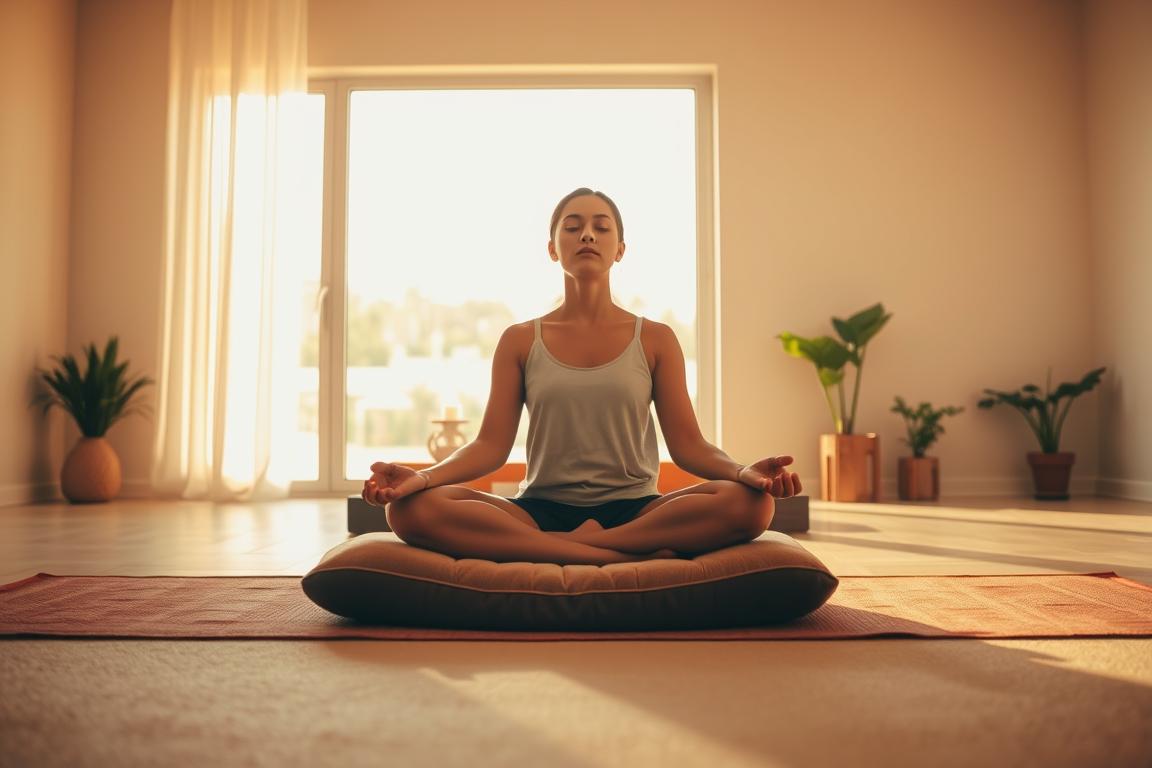The right sitting posture when meditating – tips for more comfort
Finding a comfortable sitting position is the key to successful meditation. If you have meditated before, you may be familiar with the problem: after a few minutes, your legs start to tingle or your joints ache.
The aim of meditation is to achieve inner peace and mindfulness. However, if the body is not sitting comfortably, thoughts quickly turn to pain instead of meditation itself. There is no one perfect meditation posture that suits everyone.
In this article, you will learn how to find the right sitting posture for your meditation, which will give you more comfort and a deeper experience.
Important findings
- Find your personal meditation posture for more comfort
- The right sitting posture is crucial for your concentration
- There are various sitting postures that you can adapt to your needs
- With the right tips, you will find your meditation seat
- A comfortable position allows for deeper meditation
Why the right sitting posture is crucial
The right sitting posture is the foundation for a deep and fulfilling meditation practice. If you choose to meditate, it is important that you give your body the right support so that you can concentrate fully on your inner journey.
Physical benefits of correct posture
A correct sitting posture offers numerous physical benefits. It supports the natural S-shape of your spine and therefore promotes your health. By maintaining an upright posture, you can avoid tension and pain, which are often caused by poor sitting posture.
- A stable sitting posture creates the basis for mental stability.
- The upright posture promotes alertness and presence.
Mental benefits for your meditation practice
A correct sitting posture also has a positive effect on your mental state during meditation. It helps you to improve your concentration and increase your mindfulness. With a comfortable sitting posture, you can concentrate on your meditation for longer without being distracted by physical discomfort.
- The correct sitting posture supports the free flow of energy in the body.
- With practice, you will find that a stable posture helps you to develop mental stability too.
By meditating regularly and paying attention to your sitting posture, you can deepen your meditation practice and improve your mental clarity.
Basic principles of sitting posture when meditating
The correct sitting posture when meditating is essential for comfort and effectiveness. A good meditation posture allows you to breathe freely and relaxed, which in turn improves your meditation experience.
Preserve the natural S-shape of your spine
When sitting, it is important to maintain the natural S-shape of your spine. This means that your lower back should remain straight and your abdomen soft so that you can breathe freely. Make sure that your spine is long and upright without creating too much tension.
The correct position of the head, shoulders and pelvis
The positioning of your head, shoulders and pelvis is crucial for a comfortable and effective meditation posture. Keep your head straight and relax your shoulders. Your pelvis should be in a neutral position so that you don’t tilt forwards or backwards.
Keep breathing and body tension in balance
A good meditation posture allows you to breathe freely and deeply. Make sure that your belly remains soft and is not constricted. Find a balance between upright posture and relaxation, as too much tension can block your breath, while too little tension can cause you to slump.
- A good meditation posture allows you to breathe freely and relaxed – make sure that your abdominal area remains soft and is not constricted.
- Find the balance between upright posture and relaxation.
- Your breathing can serve as an indicator: If you cannot breathe freely and deeply, your sitting posture is probably not optimal.
The best meditation seats at a glance
There are various meditation seats that you can try out to find the one that suits you best. The right sitting position can significantly improve your meditation practice.

Lotus position and half lotus position
The lotus position is a classic meditation pose in which both feet rest on the opposite thighs. This position promotes an upright posture and can improve concentration. The half lotus position is a variation in which only one foot rests on the opposite thigh.
Both positions require a certain amount of flexibility, especially in the hips and knees. If you are not yet so flexible, you can start with the half lotus position or try alternative sitting positions.
Cross-legged pose (Sukhasana) and Comfortable pose (Muktasana)
Cross-legged pose, also known as Sukhasana, is a simple and comfortable sitting position in which the legs are crossed. The Comfortable Seat or Muktasana is similar to the cross-legged pose, but the legs are arranged slightly differently, which can be more comfortable for some people.
These sitting positions are good for beginners as they require less flexibility than the lotus position. Make sure that your back remains straight and your shoulders are relaxed.
Heel position (Vajrasana)
Heel pose, also known as Vajrasana, is a kneeling position in which you sit on your heels. This pose can be very stable and helps to keep your back straight.
The heel sit can also be helpful to promote blood circulation in the legs and strengthen the knees. However, if you have problems with your knees, you should try this position with caution.
Meditating on the chair
Meditating on a chair is an excellent option for people with knee or back problems. Sit upright on the front half of the seat without leaning against it and make sure your feet are flat on the floor.
A chair with a straight seat is ideal. If necessary, you can place a cushion under your feet to find a comfortable position. This method can be used anywhere, whether in the office or at home.
Aids for a comfortable meditation seat
The correct sitting posture when meditating can be supported by various aids that you can either buy specially or improvise from everyday objects. These aids can make a decisive contribution to ensuring that you can sit comfortably and upright during your meditation.
Meditation cushions and yoga blocks
You can use meditation cushions and yoga blocks for an optimal sitting posture. A meditation cushion supports your spine and helps you to sit upright. Yoga blocks can be placed under your knees or buttocks to stabilize your posture. If you don’t have any special meditation accessories, you can also use everyday objects.
Alternatives with everyday objects
You don’t need any special meditation accessories to meditate comfortably. Many everyday objects can serve as effective aids. For example, a tightly rolled or folded blanket can be used as a seat cushion. Firm sofa cushions or several cushions stacked on top of each other can be a good alternative to a meditation cushion. Thick books can be used as a substitute for yoga blocks and placed under your knees or buttocks. If you are meditating on a chair, a small cushion in the lower back area can support the natural curve of your spine.
- A folded blanket or hard cushion can be placed under your feet if they don’t reach the floor to support your posture.
- By using such aids, you can adjust your posture and find a comfortable sitting position.
Dealing with discomfort during meditation
It is completely normal to experience physical discomfort during meditation, especially as a beginner. Ailments such as knee or back problems can affect your meditation practice.
Tips for knee and back problems
If you experience knee or back problems during meditation, there are a few tips that can help you. First, make sure your sitting position is correct and that your spine retains its natural S-shape. The correct positioning of your head, shoulders and pelvis is crucial to finding a comfortable sitting posture.
Be sure to stretch your legs briefly in between or change your position if you notice any pain. As you practise, it will become easier and the amount of time you can hold your seat comfortably and without distraction will increase.
When you should change your position
Pay attention to your body’s signals: tingling, numbness or stabbing pains are clear indications that you should change your position. A good guideline is to change your position if the physical discomfort becomes so severe that it completely distracts you from your meditation.
- It’s perfectly fine to change your position during meditation, especially as a beginner or for longer sessions.
- With practice, the amount of time you can comfortably stay in one position will increase – be patient with yourself and respect the process.
- If you need to change your position, do so consciously and mindfully – make it part of your meditation practice by performing the movement slowly and with full attention.
By listening to your body and adjusting your position accordingly, you can improve your meditation practice and have a deep, relaxed experience.
Conclusion: finding your personal meditation posture
Find your own meditation posture with patience and practice. It is important that you do a short check-in with yourself before each meditation practice to understand your needs. The right sitting posture supports your meditation and your meditation. Being mindful of your body and mind helps you to find the right posture. Over time, you will discover your personal meditation posture, which will enable you to dive deeper into meditation.
Remember that the outer form is less important than your inner experience. With mindfulness and respect for your body, you will find your way.



